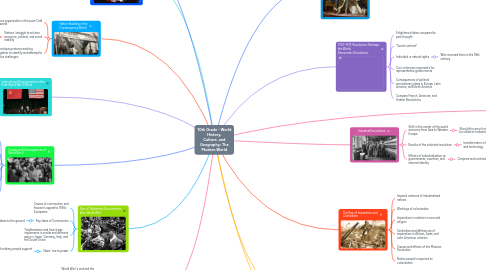10th Grade - World History, Culture, and Geography: The Modern World
Door Edward Tu


1. Nation-Building in the Contemporary World
1.1. Nations organization in the post-Cold War world
1.2. Nations' struggle to achieve economic, political, and social stability
1.2.1. Compare
1.3. Developing nations working together to identify and attempt to solve challenges
2. Effects of World War I
2.1. World War I's end and the consequences of the postwar agreement
2.2. The impact of the agreements on the map of the Middle East
2.3. Ordinary people in a postwar world
2.4. "Lost generation"
2.4.1. People who lived through or ones that came of age
2.5. The world order's contribution to the collapse of the worldwide economy
3. International Developments in the Post-World War II World
3.1. Development of the Cold War
3.2. How was the Cold War waged all over the world?
3.3. Former colonies response to the Cold War and liberation
3.4. How and why did the Cold War end?
4. Causes and Consequences of World War II
4.1. Why was the death toll so high during WWII
4.2. Key goals of the Axis and Allied powers
4.2.1. Mobilization on different fronts
4.3. The role of technology in WWII
4.4. WWII as a total war
4.5. Compare the actors, goals, and strategies of WWII and WWI
4.6. the Holocaust
5. Rise of Totalitarian Governments after World War I
5.1. Causes of communism and fascism's appeal to 1930s Europeans
5.2. Key ideas of Communism
5.2.1. Translation of ideas to the ground
5.3. Totalitarianism and how it was implements in similar and different ways in Japan, Germany, Italy, and the Soviet Union
5.4. Nazis' rise to power
5.4.1. Why did oridnary people support them
6. Economic Integration and Contemporary Revolutions in Information, Technology, and Communications
6.1. Effect of globalization on people, nations, and capital
6.2. Facilitation of extremist and terrorist organizations by the post-Cold War world and globalization
7. Activity 3: Students will draw upon their own experiences in a quickwrite about how globalization has affected themselves and their family. They may and are encouraged to discuss their family's history, regarding immigration and culture. How does the student's culture differ from that of their families, if at all? How has technology broaden or narrowed our perception of the world?
8. The World in 1750
8.1. Organization of societies in the 1700s
8.2. The ones in power
8.2.1. Who and Why
8.3. Divine right of kings
9. 1750–1917: Revolutions Reshape the World Democratic Revolutions
9.1. Enlightened ideas compared to past thought
9.2. "Social contract"
9.3. Individual or natural rights
9.3.1. Who received them in the 18th century
9.4. Civic reformers arguments for representative governments
9.5. Consequences of political revolutionary ideas in Europe, Latin America, and North America
9.6. Compare French, American, and Haitian Revolutions
10. Industrial Revolutions
10.1. Shift in the center of the world economy from Asia to Western Europe
10.1.1. Should this era of industrialization be called an Industrial Revolution?
10.2. Results of the industrial revolution
10.2.1. transformation of the environment and technology
10.3. Effects of industrialization on governments, countries, and national identity
10.3.1. Compare and contrast
11. The Rise of Imperialism and Colonialism
11.1. Imperial ventures of industrialized nations
11.2. Workings of colonization
11.3. Imperialism in relation to race and religion
11.4. Similarities and differences of imperialism in African, Asian, and Latin American colonies
11.5. Causes and effects of the Mexican Revolution
11.6. Native people's response to colonization
12. Causes and Course of World War I
12.1. From Great war to World War
12.1.1. colonization's role in the its spread from Europe to overseas holdings
12.2. Total war
12.3. Consequences of WWI for nations and its' people
12.4. Russian Revolution
12.4.1. the development of the revolution itself and its popularity
